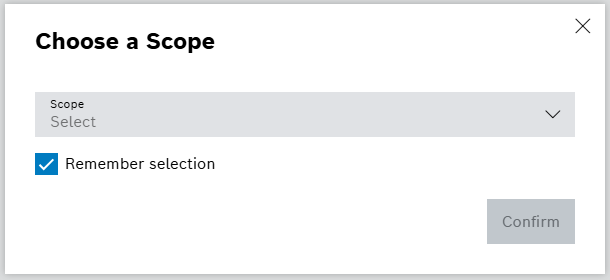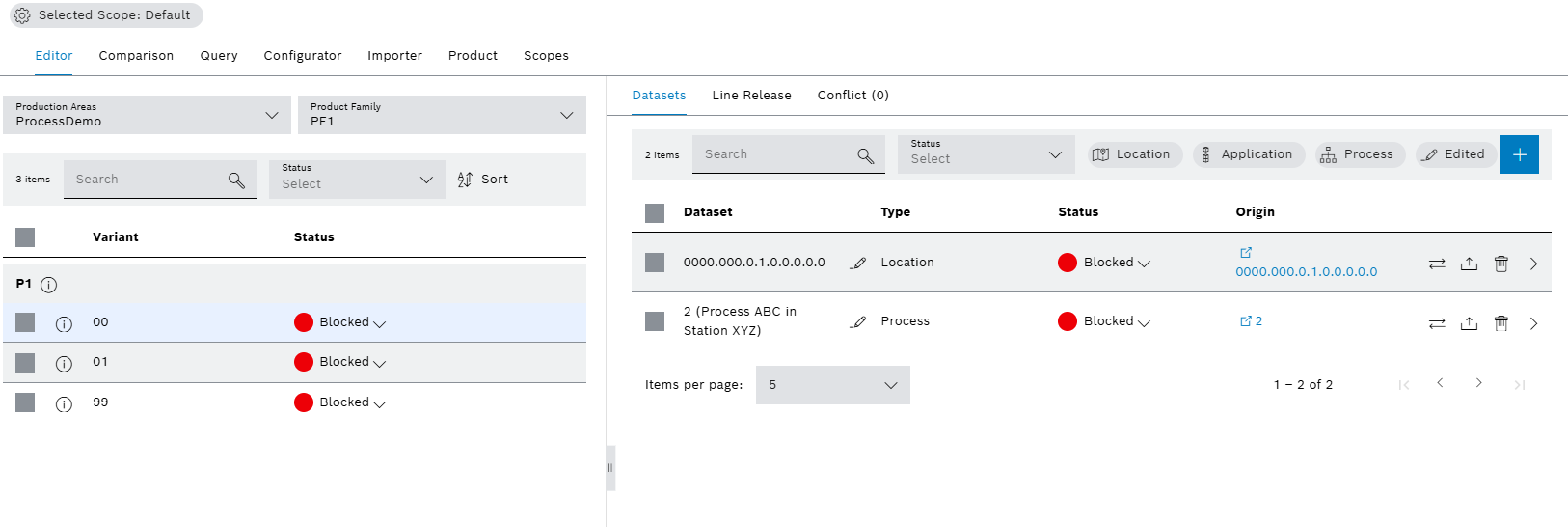Basic setup
The Basic Setup section provides an overview of the initial configuration required to use the Setup Specs module effectively.
Initial scope selection
Setup Specs operates with database connections defined as Scope. Select at least one Scope to start Setup Specs.
|
Setup Specs selects Default Scope in the start automatically if there is no other defined Scope. |

To maintain scopes, refer to the introduction page on selection of the initial scope Selecting Scope.
States of datasets
Typically, datasets are in the responsibility of Production Planners.
The contents of single datasets are under the responsibility of specialized Process Experts.
States of datasets are explicitly useful to increase the transparency for the Planner.
Experts approve the edited datasets, then the approved dataset becomes a part of the next release of the related dataset.
The state of the dataset also represents the state when the dataset is still in work, or blocked by the Process Experts.
The default state of a new dataset is the blocked state.
| States of Datasets | Description |
|---|---|
Released |
Change the state of dataset to released to release the dataset. The dataset will then replace the latest released dataset. |
Emergency Released |
Temporarily released state to address further necessary process decisions. For example, use this state when there is no process expert available with the rights to set dataset to released state within the exact period. |
Blocked |
The blocked state addresses datasets which are not released. When the time for releasing from the state emergency released expired, the dataset goes to blocked state. |
States of variants
A new variant is always created in blocked state. Changes on released dataset update the state of variant from released state to preparation state automatically.
| States of Variants | Constraints According to States of Datasets | Authorized Roles | Description |
|---|---|---|---|
Preparation |
None |
Planer |
The preparation state addresses the changes on dataset level under the variant. |
Try Out |
None |
Planner Advanced |
An alternative released state in the try-out phase of a product. |
Released |
All datasets of the variant are in released state. |
Planner Basic, Planner Advanced |
Change the state of variant to the released state to release the variant for production. |
Released |
All datasets of the variant are in released state. |
Planner Basic, Planner Advanced |
Released state for only one variant. |
Phase Out |
All datasets of the variant are in released state. |
Planner Basic, Planner Advanced |
Released state used for internal management to address phase-out release. |
Blocked |
None |
Planner Basic, Planner Advanced |
Blocked state addresses variant having values which are not available for the station. |
Invalid |
None |
Planner Basic, Planner Advanced |
Invalid state variants are irrelevant for the station. |
|
To release a variant, release all the datasets and resolve all open tickets in Ticket Management. |
States of line releases
A change of a line status does not affect the dataset or variant status. Line Release addresses the production eligibility of variant on a certain line based on the latest release.
| States of Line Releases | Description |
|---|---|
Try Out |
A TryOut state marks a try-out phase of the product which works as released state. |
Released |
A released line marks that a potential Try Out phase is over and the line is ready for production. |
Phase Out |
A Phase Out state is internal released state and will provide dataset to the station, marking for the user that the production is in a phase-out state for this line. |
Blocked |
Blocked lines are not available for the station. |
Human-readable process and location names
To display human-readable process and location names in Setup Specs, configure the names under topology in Master Data Management and processes in Master Data Management. Setup Specs displays the configured names of processes and locations next to the Dataset IDs over the whole module in brackets:

